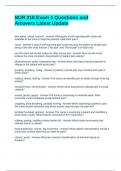NUR 218 Exam 1 Questions and
Answers Latest Update
descriptive, visual, numeric - Answer-What types of self-reporting pain scales are
available to the nurse to help the patients relate their pain?
visual - Answer-a type of self-reporting pain scale that asks the patient to identify pain
along a line with word anchors ("No pain" and "Worst pain") on each end:
use the same set of pain scales as other nurses use - Answer-How can the nurse
achieve the most consistent interpretation of patient pain ratings?
blood pressure, pulse, respiratory rate - Answer-What vital signs may be expected to
change in the patient with acute pain?
grunting, groaning, crying - Answer-A patient in acute pain may vocalize their pain in
which ways?
restless, drawn, kicking - Answer-The nurse can identify pain in infants through what leg
activity?
constant frown, clenched jaw - Answer-Which facial expressions indicate pain in young
children?
moans, grunts, gasps - Answer-The nurse is assessing a nonverbal adult. What
nonverbal vocal complaints would indicate pain?
coughing, deep breathing, possibly moving - Answer-When assessing a patient's pain,
the nurse should remember that which actions may increase the pain felt?
wrinkled forehead, grimace - Answer-The nurse is examining a patient and identifies a
facial mask of pain. What features characterize this expression?
rubbing, pacing, inability to keep hands still - Answer-Which body movements may
indicate pain in a patient?
facial expression, activity, leg movement - Answer-What patient characteristics should a
nurse look at when observing an infant for pain?
chronic, acute - Answer-What are common classifications of infection based on
duration?
,lethargy; Persistent lethargy can be a symptom of systemic disease, such as a urinary
tract infection or septicemia. - Answer-What is a clinical manifestation of a systemic
infection?
localized - Answer-type of infection that usually occur in areas of skin and mucous
membrane breakdown, such as surgical and traumatic wounds, pressure ulcers, oral
lesions, and abscesses:
They can cause redness, swelling, warmth, pain, tenderness, drainage, numbness or
tingling, and loss of function to the affected area. - Answer-effects of localized
infections:
indicates a localized infection. - Answer-what does a tooth with an abscess indicate?
chills - Answer-A post-surgical patient has a localized infection of the incision. Which
symptom exhibited by the patient may indicate a systemic infection?
can cause fever, increases in heart and respiratory rates, lethargy, anorexia, and
tenderness or enlargement of lymph nodes - Answer-what can systemic infections
cause?
chills - Answer------ are a manifestation of a systemic infection commonly observed with
high fevers.
false. it may indicate a localized infection - Answer-true or false: Warmth, redness, and
localized swelling indicates a systemic infection
localized - Answer-what type of infection does drainage indicate?
Septicemia - Answer-A nurse is caring for a patient with a severe infection whose blood
pressure is 87/42. What does the nurse suspect?
septicemia and sometimes shock - Answer-a decreased blood pressure is a late sign of
infection indicating what?
Chronic diseases
Alterations in the immune system
Medications such as chemotherapeutic drugs
Alterations in skin integrity
Malnutrition and dehydration
Indwelling medical devices such as urinary catheters
Lack of proper immunizations - Answer-Which conditions place the patient at a higher
risk for infection?
100 - Answer-The WBC count differential is the proportion of each type of WBC out of
----- cells.
, Number of RBCs, WBCs, platelets, and reticulocytes - Answer-what does a Complete
blood count (CBC) measure?
Finds cause of infection and antibiotic treatment - Answer-what does a Culture and
sensitivity (C&S) measure?
Determines number of each type of WBC - Answer-what does a Differential white blood
count (WBC) measure?
Measures degree of inflammation in the body - Answer-what does a Erythrocyte
sedimentation rate (ESR) measure?
communicable - Answer-infants are at a higher risk for developing what kind of
diseases?
loss of elasticity, decreased blood supply, increase in dryness - Answer-What skin
changes in older adults puts them at a higher risk for skin infections?
respiratory, skin, UTIs - Answer-The nurse is preparing discharge instructions to a
newly paralyzed young man about high-risk conditions that can occur as a result of
immobility. Which of these conditions should the nurse include in her teaching?
culture - Answer-A couple informs the nurse that they do not believe in taking their
newborn child to see a health care provider until the age of three. Which diversity
consideration is the couple demonstrating?
systemic - Answer-flu s considered what type of infection?
localized infection - Answer-A swollen, red cuticle is specific to an area (skin) and
indicates what?
disability, gender - Answer-Which factors increase the risk of an individual catching an
infection?
Patient is responding poorly to therapy, Patient is experiencing inflammation and may
have an infection. - Answer-While caring for a patient at high risk for developing an
infection, the nurse observes that the patient's ESR remains elevated for the past three
days. What can the nurse consider based on these results?
Performing a general assessment, checking vital signs, viewing a full history - Answer-
Which are strategies of collecting key patient assessment data?
increased BP, increased pulse, increased temp - Answer-Which vital signs when altered
may indicate an infection?





